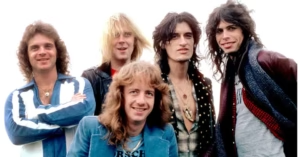Rainbow: The Arc of Hard Rock Majesty
Rainbow. Genesis of a Storm: Ritchie Blackmore’s Vision (1975)
Rainbow was formed in 1975 by Ritchie Blackmore, the virtuoso guitarist and founding member of Deep Purple, at a time when he was increasingly frustrated with Purple’s musical direction, especially the funkier style that emerged during the Stormbringer era. Seeking greater creative control and a return to a heavier, more classical and melodic hard rock sound, Blackmore left Deep Purple and formed a new band initially as a solo project.
His first collaborator was Ronnie James Dio, the charismatic vocalist of the New York-based band Elf, which had previously opened for Deep Purple. Blackmore hired the entire Elf lineup to record the debut album, but quickly took control and restructured the band around Dio, parting ways with the other members.
Thus, Ritchie Blackmore’s Rainbow was born.

Rainbow. The Debut: Ritchie Blackmore’s Rainbow (1975)
Rainbow’s first album, Ritchie Blackmore’s Rainbow, was released in 1975. It was a mystical blend of classical-inspired guitar riffs, Dio’s operatic vocals, and fantastical lyrics. Songs like:
- “Man on the Silver Mountain”
- “Catch the Rainbow”
- “Sixteenth Century Greensleeves”
…established the band’s thematic foundation: mythology, medieval imagery, and theatrical heavy rock. While the album leaned more toward hard rock than full metal, it became an instant cult classic and marked Dio as a vocalist of rare power.
A New Lineup, A New Force: Rising (1976)
For their second album, Blackmore overhauled the band, keeping only Dio. He brought in:
- Cozy Powell – drums (ex-Jeff Beck Group)
- Jimmy Bain – bass
- Tony Carey – keyboards
The result was Rising (1976), a record widely regarded as one of the greatest hard rock albums of all time.
Featuring only six tracks, Rising is a dramatic, powerful, and bombastic work of neoclassical hard rock, including:
- “Stargazer” – a nearly 9-minute epic with an Eastern-influenced string section, telling a tale of a mad wizard
- “Tarot Woman” and “A Light in the Black” – fast, intricate, and majestic
The synergy between Blackmore’s intricate guitar work and Dio’s soaring vocals reached its zenith here, earning Rising legendary status.
On Stage and Majestic: Live Influence (1977)
In 1977, Rainbow released On Stage, a double live album that captured their explosive energy. Featuring extended versions of songs like “Catch the Rainbow” and “Mistreated” (from Blackmore’s Deep Purple days), the album highlighted the band’s live improvisational power, with Cozy Powell’s drumming often stealing the show.
Long Live Rock ‘n’ Roll (1978): The Last Dio Era Album
Long Live Rock ‘n’ Roll, released in 1978, was the last studio album to feature Ronnie James Dio. It included classics like:
- “Gates of Babylon” – complete with orchestral arrangements
- “Kill the King” – a speed metal precursor
- “Rainbow Eyes” – a softer, haunting ballad with flute and string textures
Despite creative tension, the album cemented Rainbow as a band capable of balancing aggression, melody, and grandeur. But the partnership between Blackmore and Dio had run its course.

The Transition: Post-Dio Years and Mainstream Shift
After Dio’s departure in 1979 (he would later join Black Sabbath), Blackmore reshaped Rainbow yet again. He brought in Graham Bonnet on vocals for Down to Earth (1979), an album with more commercial leanings. It yielded two hit singles:
- “Since You Been Gone” (written by Russ Ballard) – a huge radio hit
- “All Night Long” – a party anthem
The shift from epic, mystical rock to catchy hard rock alienated some older fans but brought Rainbow chart success.
Joe Lynn Turner Era (1980–1984): AOR Dominance
In the early 1980s, Rainbow transformed into a more radio-friendly, melodic rock band. With Joe Lynn Turner as vocalist and Roger Glover (ex-Deep Purple) as bassist and producer, albums like:
- Difficult to Cure (1981) – featuring “I Surrender”, “Spotlight Kid”
- Straight Between the Eyes (1982) – with “Stone Cold”
- Bent Out of Shape (1983) – including “Street of Dreams”
…showed a band aligning more with the rising AOR sound of bands like Journey or Foreigner. While still successful, Rainbow’s identity shifted significantly, with less emphasis on the medieval and mythic and more focus on polished, radio-ready hooks.
After the Bent Out of Shape tour, Blackmore dissolved Rainbow in 1984 to rejoin a reformed Deep Purple (the classic “Mark II” lineup).

Reunion and Revival (1994–1997)
In 1994, after leaving Deep Purple again, Blackmore resurrected Rainbow with an entirely new lineup. The album Stranger in Us All (1995), featuring Scottish vocalist Doogie White, returned to a heavier and more mystical tone.
Though not a massive commercial success, the album and its subsequent tour reignited interest in Rainbow’s legacy. Songs like “Black Masquerade” and “Hunting Humans” were praised by fans as a return to form.
After a few years, Blackmore shifted focus to his Renaissance-inspired folk project Blackmore’s Night, effectively ending Rainbow once more.
Rainbow’s Return (2016–present, sporadic)
In 2016, Blackmore announced a short revival of Rainbow for live performances, this time with a new lineup including vocalist Ronnie Romero, known for his work with Lords of Black. These shows, mostly focused on Rainbow and Deep Purple classics, were enthusiastically received despite no new studio album emerging.
Rainbow. Band Members (Key Figures Across Eras)
- Ritchie Blackmore – Guitar (constant member)
- Ronnie James Dio – Vocals (1975–1979)
- Cozy Powell – Drums (1975–1980)
- Graham Bonnet – Vocals (1979–1980)
- Joe Lynn Turner – Vocals (1980–1984)
- Roger Glover – Bass (1980–1984)
- Doogie White – Vocals (1994–1997)
- Ronnie Romero – Vocals (2016–present, live)
Rainbow. Studio Discography
- Ritchie Blackmore’s Rainbow (1975)
- Rising (1976)
- Long Live Rock ‘n’ Roll (1978)
- Down to Earth (1979)
- Difficult to Cure (1981)
- Straight Between the Eyes (1982)
- Bent Out of Shape (1983)
- Stranger in Us All (1995)
Rainbow. Legacy and Influence
Rainbow’s influence reaches across genres:
- Dio-era Rainbow laid the foundation for power metal and symphonic metal, inspiring bands like Helloween, Nightwish, and Blind Guardian.
- Blackmore’s blend of classical structures with heavy rock shaped the evolution of neoclassical guitar playing.
- Vocalists like Bruce Dickinson, Rob Halford, and Jorn Lande cite Rainbow as a key influence.
Despite constant lineup changes, Rainbow’s impact on hard rock, heavy metal, and progressive rock remains profound. Their music fused fantasy with ferocity, melody with might, and created an enduring legacy that shines across decades.





